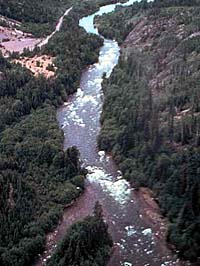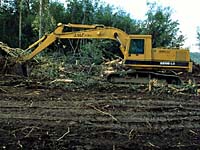
Water Flows
Stream flow determines a waterbody's ability to support aquatic life. Stable streams with year round flows provide the best habitat for fish. But, intermittent streams that flow only during snowmelt or after large rainfalls, offer habitat for critical stages in a fish's lifecycle such as spawning and rearing.

Studies show that during spring spawning, more young fish are produced in years when runoff and water levels are high than when they are low. High water creates more spawning habitat and makes it easier for fish to pass obstructions when swimming upstream. |
Compared to natural seasonal variations in flows, daily changes caused by large dams can take a toll on fish and fish habitat. Sudden increase in flow dislodge fish eggs and deposit them in areas less suitable for survival. Reductions in flow may reduce water levels in areas that just hours earlier were good spawning and incubation habitat.
Regulated flows, unless carefully calculated to accommodate the seasonal needs of fish, can limit habitat and block access during spawning and other critical life stages. They can also limit fish migration as rapids and falls become impassable at lower water levels.
Stagnant surface water that often builds up behind large dams is sometimes released to clear the upstream reservoir of algae. This oxygen-starved water makes its way downstream to fish, often killing them. | ||
Oxygen deficient water can also be released from the bottom of reservoirs through submerged intakes of hydroelectric turbines, with the same effect. Releasing cold bottom water from reservoirs can also cause thermal shock in fish.
Water diverted through irrigation can reduce instream water flows -- disastrous in low-flow years during dry summers. Fish run out of good habitat as pollutants build-up, temperatures rise, oxygen levels drop and waters become stagnant.
Improper sized mesh on irrigator intake pipes can result in loss of small fish; decreasing populations.

Clearing land and drainage work often leads to higher peak flows in spring, as well as flow changes over the rest of the year. With increased peak flows and runoff in spring, flows recede quickly, reducing water in spawning beds and stranding adult spawning fish. Rearing and incubation habitat for newly hatched fish is also reduced or destroyed. |